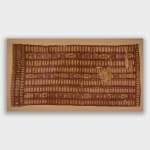Inca Culture 1400 AD-1500 AD
Tunic Panel (in Golden Color), Circa. 1400AD
Camelid fibres
72 x 144 cm
28,3 x 56,6 in
28,3 x 56,6 in
INC0006
Copyright of Paul Hughes Fine Arts
Actual Amazon bird feathers were much prised and valued in Andean Pre-Columbian cul-ture, this created a need for the feather motif to be imitated and woven in tapestry. This ex-ceptional...
Actual Amazon bird feathers were much prised and valued in Andean Pre-Columbian cul-ture, this created a need for the feather motif to be imitated and woven in tapestry. This ex-ceptional example belongs to the most recognised and most powerful empire of the Pre-Co-lumbian period—the Inca Empire. The piece is an excellent example for illustrating that, in comparison to its ancestors, the Incan artists favoured superbly woven tapestries and textiles embellished with appliqué feathers, gold and metal. The central iconography of feather motifs is meticulously rendered. Its layout, namely, the "Tocapu (a row of small square or rectangular,” revealed the Incan’s predilection for order and reasons.To ensure the steady production of such exquisite textiles, the Inca established production centres throughout their territory. Much larger than any workhouse then in existence in Europe, these textile production centres were run by highly skilled women and men trained from a young age to be the finest weavers in the empire. When the Spanish arrived, these textile centres came under direct attack as the veneration of textiles and their imagery was considered non-Christian.
Join our mailing list
* denotes required fields
We will process the personal data you have supplied in accordance with our privacy policy (available on request). You can unsubscribe or change your preferences at any time by clicking the link in our emails.



